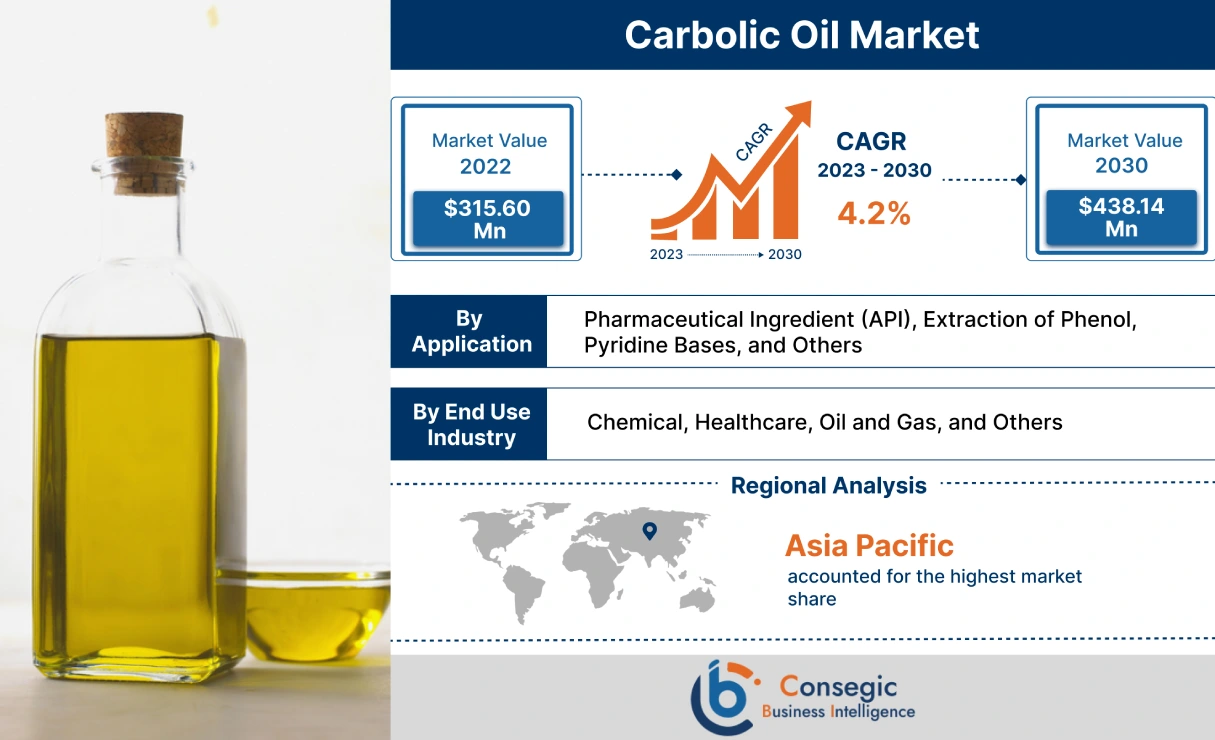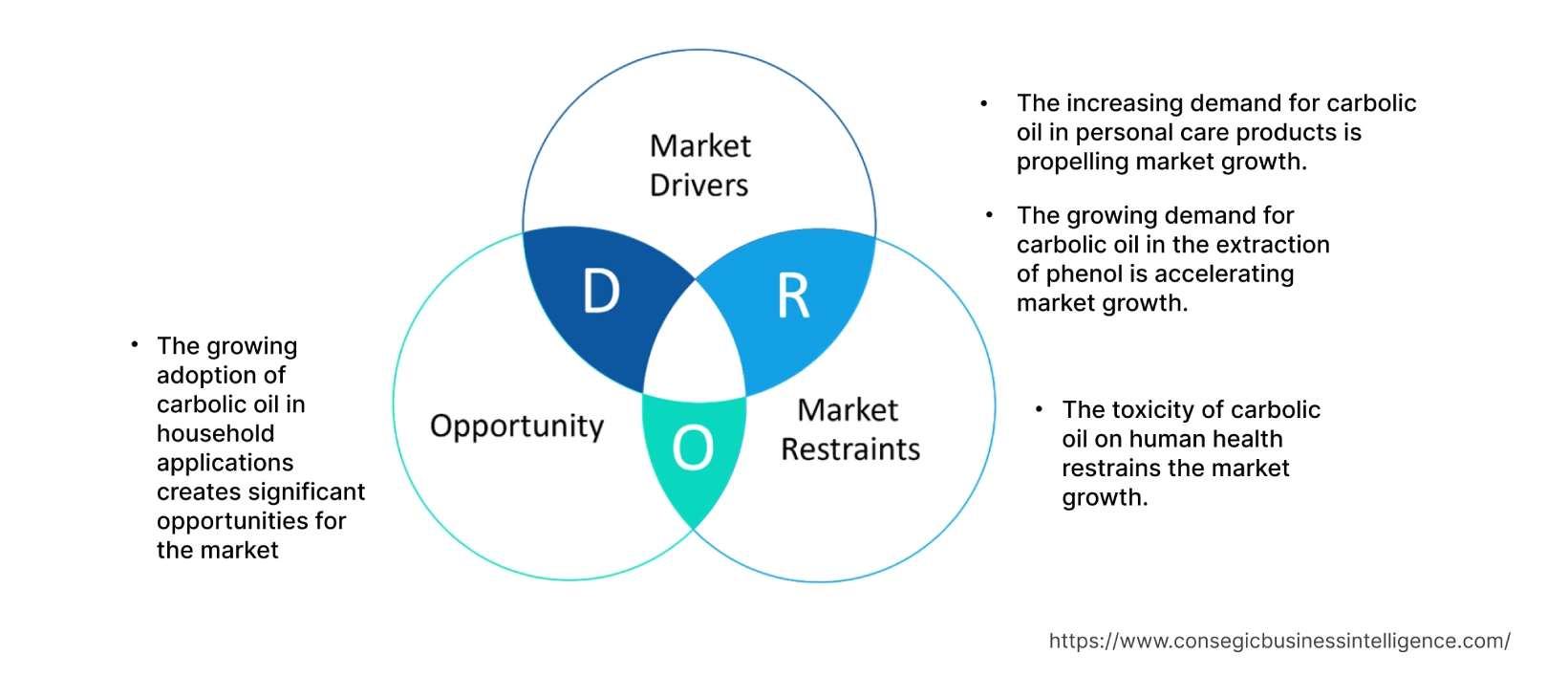Carbolic Oil Market Introduction :
Consegic Business Intelligence analyzes that the carbolic oil market is growing with a healthy CAGR of 4.2% during the forecast period (2023-2030), and the market is projected to be valued at USD 438.14 Million by 2030 from USD 315.60 Million in 2022.
Carbolic Oil Market Definition & Overview:
Carbolic oil is a complex mixture of hydrocarbons obtained by distillation of coal tar. It consists of aromatic and other hydrocarbons, phenolic compounds and aromatic nitrogen compounds and distills at the approximate range of 150°C to 210°C (302°F to 410°F).Carbolic oil is a dark, oily liquid that is derived from coal tar. Carbolic oil is a byproduct of the coal distillation process where coal is heated in the absence of air to produce various chemical compounds. Carbolic oil is mainly used as a raw material in the production of other chemicals, such as phenol, nylon, and plastics. It is also used as a moth repellent and a wood preservative. It has been used in various industrial applications including disinfectants, pharmaceuticals, and precursors for the production of chemical and synthetic materials.
Carbolic Oil Market Insights :
Carbolic Oil Market Dynamics - (DRO) :
Key Drivers :
The increasing demand for carbolic oil in personal care products is propelling market growth
Carbolic oil is used as a solvent in the production of personal care products such as sunscreen, soap, lotion, and facewash due to its antimicrobial properties and as a fragrance ingredient. The rising consumer demand for personal care products, driven by factors such as hygiene consciousness and growing trends, contributes to the growth of the carbolic oil market. Carbolic oil is used in perfumes because of its strong, antiseptic odor. For instance, according to the National Investment Promotion and Facilitation Agency, The Indian perfumes and deodorants market stood at USD 368.00 million in 2022 and is projected to surpass USD 473.00 million by 2026 growing at a CAGR of over 6.4%. Fragrance products, which comprise perfumes, deodorants, and colognes, have distinguished themselves as essential personal care products in recent years. Furthermore, the rising demand for personal care products in consumers has increased the adoption of carbolic oil. This prominent factor is boosting the market growth.
The growing demand for carbolic oil in the extraction of phenol is accelerating market growth
Phenol is a chemical compound that is commonly derived from carbolic oil, which is obtained from coal tar. Phenol has various industrious applications including the production of plastics, resins, adhesives, and pharmaceuticals. Carbolic oil is a key source of phenol production, as it contains high concentrations of phenolic compounds. As industries such as automotive, construction, and electronics continue to expand, the demand for phenol and its derivatives is increasing. This, in turn, drives the demand for carbolic oil as a raw material for the extraction of phenol.
Key Restraints :
The toxicity of carbolic oil on human health restrains the market growth
Carbolic acid can be highly toxic if ingested, inhaled, or absorbed through the skin. It can cause irritation, burns, and tissue damage. Prolonged or repeated exposure to carbolic acid can lead to more severe health effects, including damage to the liver, kidneys, and central nervous system.
Moreover, Carbolic acid is regulated in many countries due to its hazardous nature. There may be restrictions on its use, storage, transportation, and disposal. Hence, compliance with stringent regulations for manufacturing and increasing health issues with the usage of carbolic oil is posing a major bottleneck for market growth during the projected forecast period.
Future Opportunities :
The growing adoption of carbolic oil in household applications creates significant opportunities for the market
Carbolic oil has antiseptic properties and can be used for cleaning and disinfectant processes. Carbolic based household cleaners or disinfectants can provide an effective alternative to chemical based products, especially for surfaces prone to bacterial growth. Additionally, Carbolic oil has insecticidal properties and can be used to repel or eliminate pests such as mosquitoes, flies, or ants. This can provide long-lasting protection against pests, preventing their return and minimizing the need for frequent reapplication due to this the demand for carbolic oil has increased in household cleaning products and is used in industrial processes. Furthermore, increasing usage and application of carbolic oil for effective and safe pest management create a potential opportunity for the expansion of the carbolic oil market in the forecast years.
Carbolic Oil Market Report Insights :
| Report Attributes | Report Details |
| Study Timeline | 2017-2030 |
| Market Size in 2030 | USD 438.14 Million |
| CAGR (2023-2030) | 4.2% |
| By Application | Pharmaceutical Ingredient (API), Extraction of Phenol, Pyridine Bases, and Others |
| By End-Use Industry | Chemical, Healthcare, Oil and Gas, and Others |
| By Region | North America, Europe, Asia-Pacific, Latin America, and Middle East & Africa |
| Key Players | Jining Chenguang Coal Chemical CO. Ltd., Chinagtchem, DEZA a. s., Elkem, KUMHO P&B CHEMICALS, Hindustan Organic Chemicals Limited., INDUSTRIAL QUIMICA DEL NALON, Shanghai HaiChagn Petroleum, Equipment Co., Ltd., and Rain Industries Limited |
Carbolic Oil Market Segmental Analysis :
Based on the Application :
The application segment is categorized into pharmaceutical ingredients (API), extraction of phenol, pyridine bases, and others. In 2022, the pharmaceutical ingredients (API) segment accounted for the highest market share of 35.70% in the carbolic oil market. Carbolic oil is a key ingredient in the production of drugs and pharmaceuticals. Carbolic oil is used as an active pharmaceutical ingredient (API) or immediate compound in the synthesis of various medications. The increasing demand for pharmaceutical products is driven by factors such as population growth, advancement in healthcare, and the increased cases of chronic diseases, contributing to the growth of the segment. Carbolic oil can be used as an active pharmaceutical ingredient (API) in some medications. It is most commonly used in topical antiseptics, such as tincture of iodine. Carbolic oil can also be used in cough syrups and pain reliever.
However, the extraction of phenol segment is expected to be the fastest-growing segment during the forecast period. Carbolic oil is used in the extraction of phenol. Extracted phenol is widely used in the cosmetics industry. It is utilized in cosmetic products such as primers, sunscreen lotion, hair coloring, and skin-lightening creams. Furthermore, the growing use of cosmetic products worldwide will foster the revenue growth of the carbolic oil industry during the forecast period.
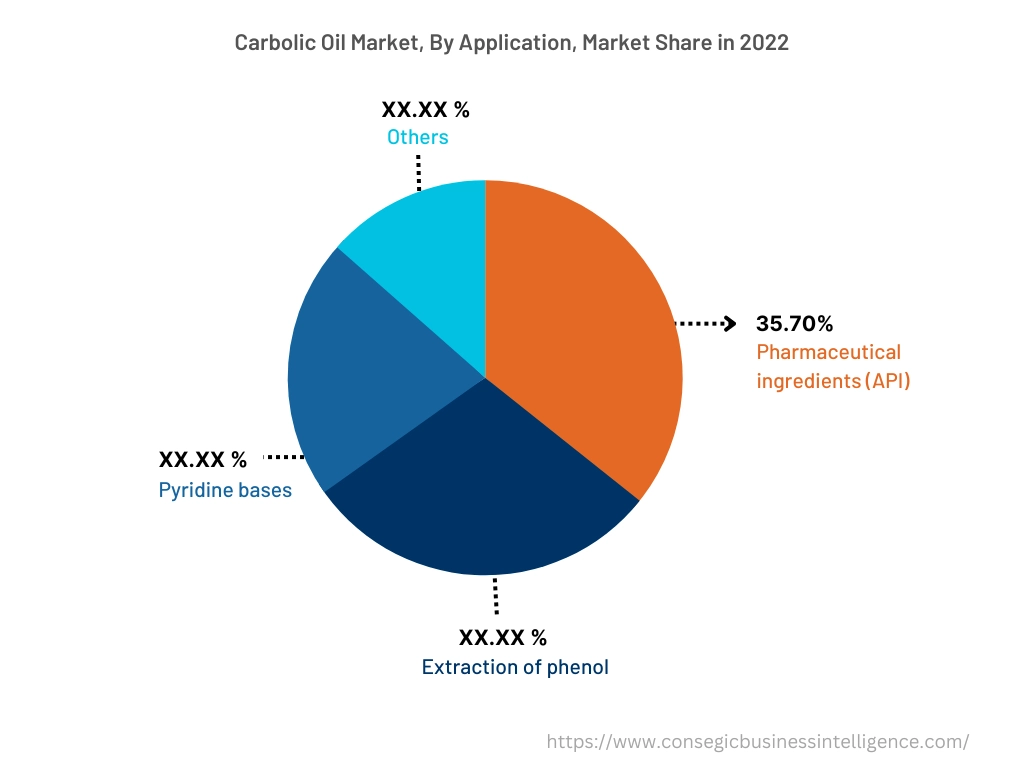
Based on the End-Use-Industry :
The application segment is categorized into chemical, healthcare, oil and gas, and others. In 2022, the chemical segment accounted for the highest market share in the overall carbolic oil market. Carbolic oil serves as a chemical intermediate in the production of various chemicals and compounds. It acts as a building block for the synthesis of resins, dyes, herbicides, and specialty chemicals. The demand for these chemicals in industries such as agriculture, textile, paint and coatings, and others contributes to the growth of the segment.
However, the healthcare segment is expected to be the fastest-growing segment during the forecast period. Carbolic oil-based products such as phenol and cresols are used as antiseptics and disinfectants in healthcare facilities. For instance, in 2020, the World Health Organization (WHO), recommended the use of disinfectants in healthcare settings and environmental surfaces including the surfaces of furniture and other fixed items. These surfaces should be frequently cleaned with water and detergent and followed by the application of a disinfectant.
Furthermore, the disinfectant properties of carbolic oil help in killing bacteria and preventing infection due to which the adoption of carbolic oil has increased in the healthcare industry and, in turn, is estimated to drive the segment growth.
Based on the Region :
The regional segment includes North America, Europe, Asia Pacific, Middle East and Africa, and Latin America.
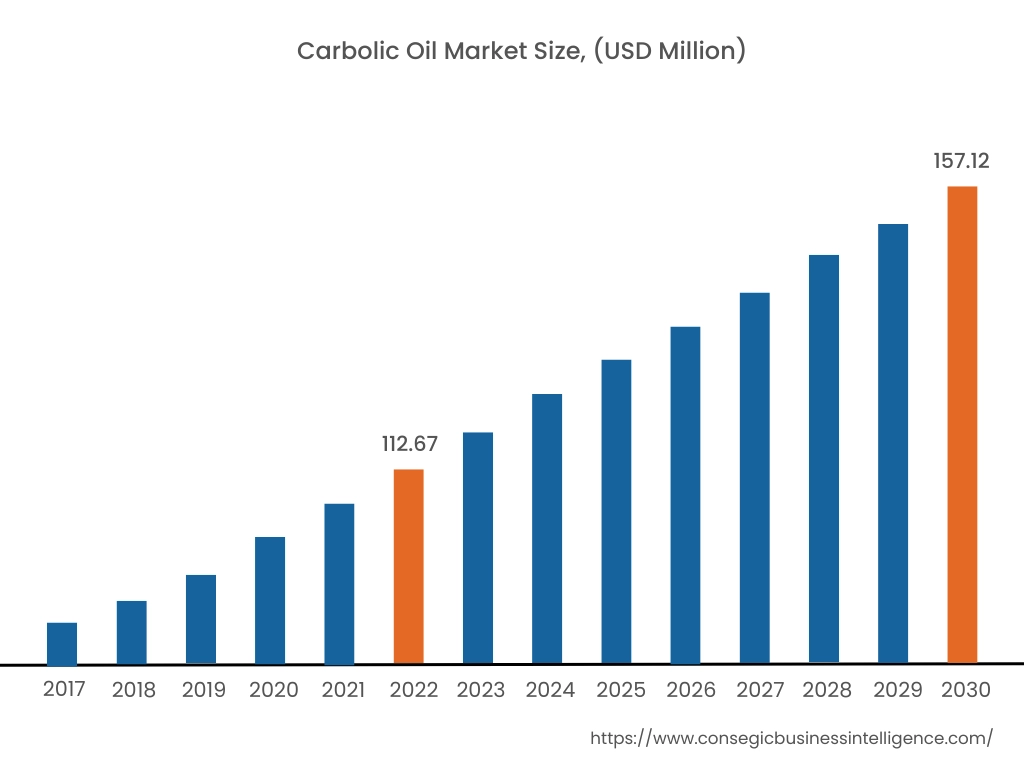
In 2022, Asia Pacific accounted for the highest market share at 35.70% valued at USD 112.67 million and is expected to reach USD 157.12 million in 2030. In Asia Pacific, China accounted for the highest market share of 22.31% during the base year of 2022. Rapid industrialization and urbanization, driving the demand for carbolic oil in various industries. Countries such as China, India, and others are major consumers of carbolic oil, particularly in the chemicals, pharmaceuticals, and construction sectors. Further, rising disposable income and increasing awareness about sustainable products can boost the demand for carbolic oil in the region.
However, North America is expected to witness significant growth over the forecast period, growing at a CAGR of 4.8% during 2023-20230. This is due to the strong demand for carbolic oil-based chemicals and products, and increasing investment in infrastructure development is further driving the demand for carbolic oil in the region.
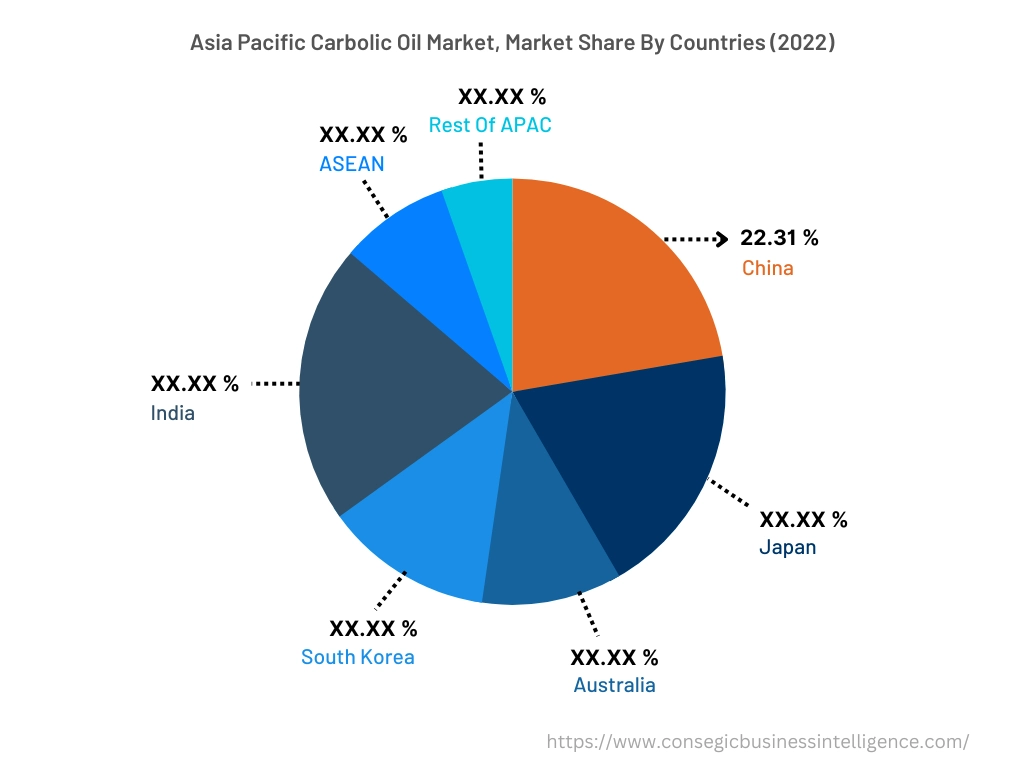
Top Key Players & Market Share Insights:
The carbolic oil market is highly competitive, with several large players and numerous small and medium-sized enterprises. These companies have strong research and development capabilities and a strong presence in the market through their extensive product portfolios and distribution networks. The market is characterized by intense competition, with companies focusing on expanding their product offerings and increasing their market share through mergers, acquisitions, and partnerships. The key players in the market include-
- Jining Chenguang Coal Chemical CO. Ltd.
- Chinagtchem
- Shanghai HaiChagn Petroleum Equipment Co., Ltd.
- Rain Industries Limited
- DEZA a. s.
- Elkem
- KUMHO P&B CHEMICALS
- Hindustan Organic Chemicals Limited.
- INDUSTRIAL QUIMICA DEL NALON
Recent Industry Developments :
- In November 2021, Elkem launched antifoam solutions for drilling fluid. Drilling fluid formulations can be aqueous or non-aqueous and contain natural or synthetic clay, fillers, lubricants, and stabilizing and dispersing agents. It generates entrapped air during manufacturing, pumping, and injection. The air or foam is detrimental to effective process control and adversely affects the safety and economy of the production process.
Key Questions Answered in the Report
What was the market size of the carbolic oil industry in 2022? +
In 2022, the market size of carbolic oil was USD 315.60 million.
What will be the potential market valuation for the carbolic oil industry by 2030? +
In 2030, the market size of carbolic oil will be expected to reach USD 438.14 million.
What are the key factors driving the growth of the carbolic oil market? +
The increasing demand for carbolic oil in personal care products, thereby fueling market growth at the global level.
What is the dominating segment in the carbolic oil market by application? +
In 2022, the pharmaceutical ingredients (API) segment accounted for the highest market share of 35.70% in the overall carbolic oil market.
Based on current market trends and future predictions, which geographical region is the dominating region in the carbolic oil market? +
Asia Pacific accounted for the highest market share in the overall carbolic oil market.
